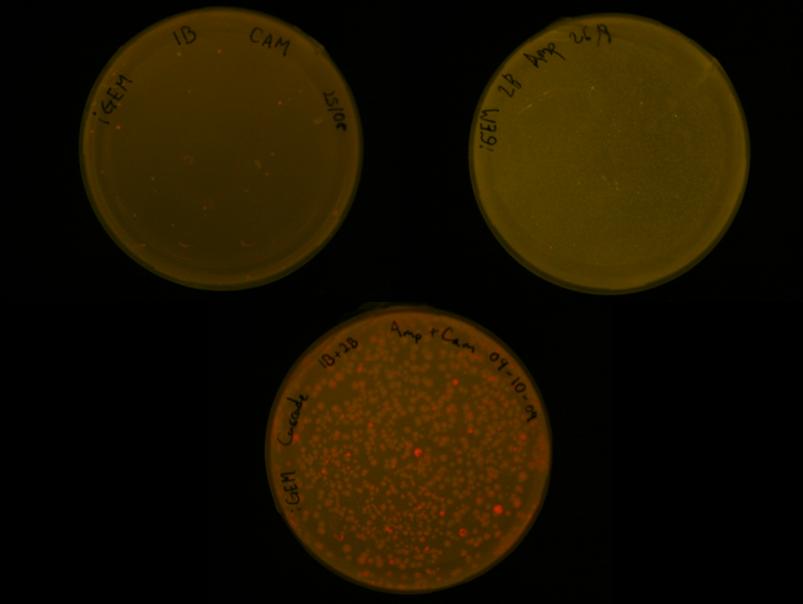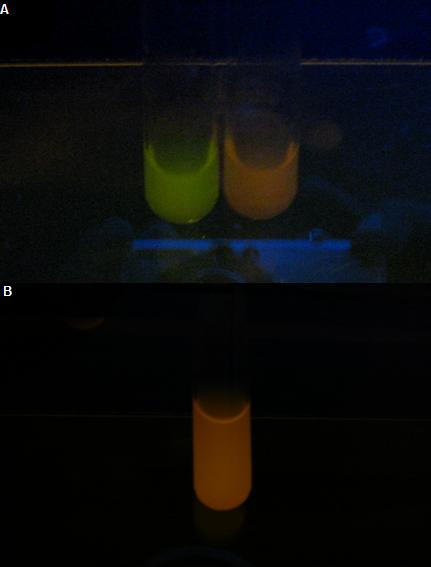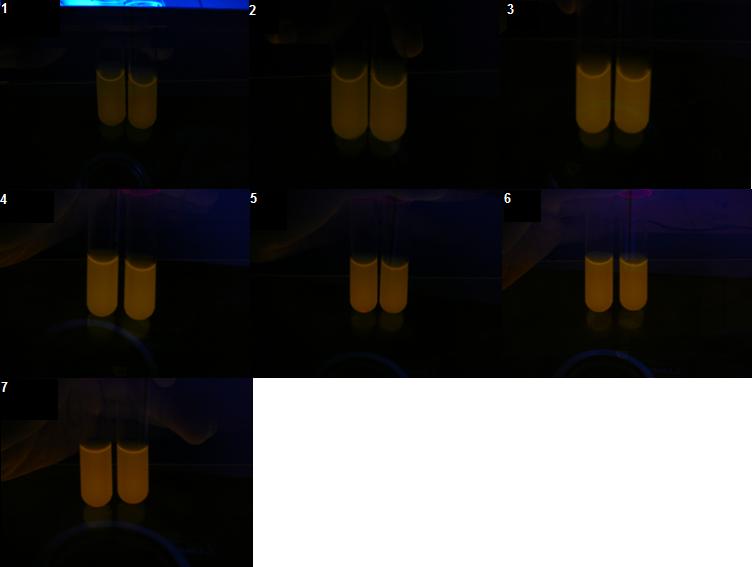Team:TUDelft/Results
From 2009.igem.org
Danielsoes (Talk | contribs) |
Danielsoes (Talk | contribs) |
||
| Line 3: | Line 3: | ||
<br> | <br> | ||
| - | + | ='''Results'''= | |
The first results obtained were the successfully assemblies of the plasmids 1 ([http://partsregistry.org/Part:BBa_K175046 K175046]) and 2 ([http://partsregistry.org/Part:BBa_K175047 K175047]) (see the [https://2009.igem.org/Team:TUDelft/Synthetic_Transcriptional_Cascade:_The_plan the plan]). [As showed in the gel image (see gel image in this page), the bands are present in the proper lengths]. After corroborate the length of the new biobricks, the biobricks were electroporated into Escherichia coli TOP10 cells (see [https://2009.igem.org/Team:TUDelft/Protocols protocols]). Besides, The samples were sent as miniprep DNA to sequence; with this it was possible to confirm the presence of the last part of the biobricks (RBS ([http://partsregistry.org/Part:BBa_B0034 B0034]) + GFP ([http://partsregistry.org/Part:BBa_E0040 E0040]) + Terminator ([http://partsregistry.org/Part:BBa_B0015 B0015])). Further investigation on the sequence should be done. | The first results obtained were the successfully assemblies of the plasmids 1 ([http://partsregistry.org/Part:BBa_K175046 K175046]) and 2 ([http://partsregistry.org/Part:BBa_K175047 K175047]) (see the [https://2009.igem.org/Team:TUDelft/Synthetic_Transcriptional_Cascade:_The_plan the plan]). [As showed in the gel image (see gel image in this page), the bands are present in the proper lengths]. After corroborate the length of the new biobricks, the biobricks were electroporated into Escherichia coli TOP10 cells (see [https://2009.igem.org/Team:TUDelft/Protocols protocols]). Besides, The samples were sent as miniprep DNA to sequence; with this it was possible to confirm the presence of the last part of the biobricks (RBS ([http://partsregistry.org/Part:BBa_B0034 B0034]) + GFP ([http://partsregistry.org/Part:BBa_E0040 E0040]) + Terminator ([http://partsregistry.org/Part:BBa_B0015 B0015])). Further investigation on the sequence should be done. | ||
| Line 25: | Line 25: | ||
[[Image:cascadekinetic.jpg|center|thumb|550px|Figure D. Preliminary synthetic transcriptional cascade test. The pictures were taken at t0=0 min,....]] | [[Image:cascadekinetic.jpg|center|thumb|550px|Figure D. Preliminary synthetic transcriptional cascade test. The pictures were taken at t0=0 min,....]] | ||
| - | + | Why did not the cascade work?, Even though similar transcriptional cascade worked before ([https://2009.igem.org/Team:TUDelft/Module_3_References 4]), our design did not. Some potential explanations could fill some gaps in this work: 1) the presence of both plasmids in one cell was not confirmed, 2) although the modelling did not showed, the degradation/production rates of the transcriptional factors could have an important contribution in this specific configuration and 3) the individual function of each plasmid was confirmed, however, other interactions not taken into account, such as robustness of the cells, might provoked the non functional performance of the plasmid 2. | |
[https://2009.igem.org/Team:TUDelft/Synthetic_Transcriptional_Cascade Return] | [https://2009.igem.org/Team:TUDelft/Synthetic_Transcriptional_Cascade Return] | ||
<br> | <br> | ||
{{Template:TUDelftiGEM2009_end}} | {{Template:TUDelftiGEM2009_end}} | ||
Revision as of 21:12, 15 October 2009
Results
The first results obtained were the successfully assemblies of the plasmids 1 ([http://partsregistry.org/Part:BBa_K175046 K175046]) and 2 ([http://partsregistry.org/Part:BBa_K175047 K175047]) (see the the plan). [As showed in the gel image (see gel image in this page), the bands are present in the proper lengths]. After corroborate the length of the new biobricks, the biobricks were electroporated into Escherichia coli TOP10 cells (see protocols). Besides, The samples were sent as miniprep DNA to sequence; with this it was possible to confirm the presence of the last part of the biobricks (RBS ([http://partsregistry.org/Part:BBa_B0034 B0034]) + GFP ([http://partsregistry.org/Part:BBa_E0040 E0040]) + Terminator ([http://partsregistry.org/Part:BBa_B0015 B0015])). Further investigation on the sequence should be done.
250 µL of the E. coli TOP10 cells carrying either the plasmid 1 or 2 were plated in an LB agar Petri dish adding the proper selection antibiotic and incubated at 37ºC overnight. The colonies in the plate for plasmid 1 showed red fluorescence and the colonies in the plate for plasmid 2 showed green fluorescence (data not shown). These results were in agreement with the expected fluorescence, Ptet ([http://partsregistry.org/Part:BBa_R0040 R0040]) act as a constitutive promoter in the absence of its repressor TetR ([http://partsregistry.org/Part:BBa_C0040 C0040]), therefore, the production of cI ([http://partsregistry.org/Part:BBa_C0051 C0051]) and RFP ([http://partsregistry.org/Part:BBa_E1010 E1010]) were present in the cells. Similar explanation could be used for the interpretation of the green glow in plasmid 2.
The delay-device is formed by the two plasmids. Therefore, both plasmids were introduced into the TOP10 cells. Following by plating and culture them using the same conditions mentioned above. In this case, the plates and culture tubes were glowing red, which is in agreement with our expectations. However in preliminary tests (data not shown), the addition of IPTG to the medium did not lead to the change of fluorescence from red to green as expected. These preliminary results indicate the lack of function of the plasmid 2 when the both plasmids are present. This conclusion is only accepted if the presence of the two plasmids in one cell is confirmed, however we could not confirm it; thus it will remain as another potential explanation.
Derived from the results in other sections of this subproject (see Lock/Key results), the plasmids were also transformed in (K12) electro-competent cells. 250 µL of the E. coli (K12) cells carrying either the plasmid 1, plasmid 2 or both were plated in an LB agar Petri dish adding the proper selection antibiotic and incubated at 37ºC overnight. As the previous results, the plates with cells containing the plasmid 1 and the colonies carrying both plasmids glowed red and the cells with the plasmid 2 glowed green (Figure B). One colony from each plate was inoculated in a 4 mL culture tube with minimal medium and the appropriate antibiotic. The tubes were incubated overnight at 37°C and 175 rpm. Once again, the expected results were confirmed as showed in the figure C.
The tube containing cells with both plasmids were used to perform a simple kinetic in order to have preliminary results for the delay time. 1mL was transfer to a tube with 4mL fresh minimal medium and incubated for 1 h at 37°C and 175 rpm. This procedure was done twice in order to have a control. After 1 h one tube was induced with 0.2 mM IPTG and the glowing was followed for 10 h.
As appreciated in figure D, no change of color was noticed and the red glow was increasing over time indicating the growth of the culture. Unfortunately, these results proved once again the non functionality of the device under the circumstances tested. Further experiments, see below, were performed with some promising results. Besides, the presence of both plasmids in one cell was not confirmed.
Why did not the cascade work?, Even though similar transcriptional cascade worked before (4), our design did not. Some potential explanations could fill some gaps in this work: 1) the presence of both plasmids in one cell was not confirmed, 2) although the modelling did not showed, the degradation/production rates of the transcriptional factors could have an important contribution in this specific configuration and 3) the individual function of each plasmid was confirmed, however, other interactions not taken into account, such as robustness of the cells, might provoked the non functional performance of the plasmid 2.
 "
"










